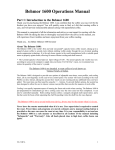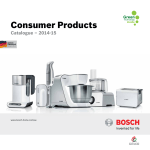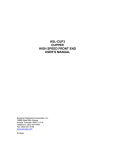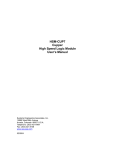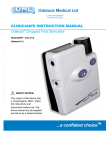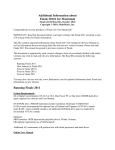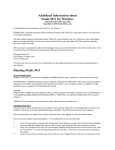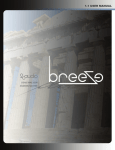Download Zach and Dani's Coffee roaster Operating instructions
Transcript
Zach & Dani’s™ Instructional Guide and Roasting Journal Table of Contents Important Safeguards . . . . . . . . . . . . . . . . . . . . . . . . . . . . . . . . . . . . . . . . . . . . . . . . . . . 2 Welcome to the world of Home Coffee Roasting . . . . . . . . . . . . . . . . . . . . . . . . . . . 3 Description of Parts . . . . . . . . . . . . . . . . . . . . . . . . . . . . . . . . . . . . . . . . . . . . . . . . . 4 Description of Control Panel . . . . . . . . . . . . . . . . . . . . . . . . . . . . . . . . . . . . . . . . . . 5 Before You Begin . . . . . . . . . . . . . . . . . . . . . . . . . . . . . . . . . . . . . . . . . . . . . . . . . . . . 6 Roasting . . . . . . . . . . . . . . . . . . . . . . . . . . . . . . . . . . . . . . . . . . . . . . . . . . . . . . . . . . 7-9 Caring for your roaster . . . . . . . . . . . . . . . . . . . . . . . . . . . . . . . . . . . . . . . . . . . . . . 10 A Few Words from Kenneth Davids . . . . . . . . . . . . . . . . . . . . . . . . . . . . . . . . . . . 11-17 • • • • • • • Why Roast Coffee at Home What Does Roasting Do to Coffee? What Influences the Taste of Coffee? Blending: Categories Blending for Taste and Variety How to Set Up Your Own Coffee Cellar Storing and Handling Coffee After Roasting Roasting Journal . . . . . . . . . . . . . . . . . . . . . . . . . . . . . . . . . . . . . . . . . . . . . . . . . . . . . . . 18 Troubleshooting . . . . . . . . . . . . . . . . . . . . . . . . . . . . . . . . . . . . . . . . . . . . . . . . . . . . 19-20 Guarantee . . . . . . . . . . . . . . . . . . . . . . . . . . . . . . . . . . . . . . . . . . . . . . . . . . . . . . . . . . . . . 21 Warranty . . . . . . . . . . . . . . . . . . . . . . . . . . . . . . . . . . . . . . . . . . . . . . . . . . . . . . . . . . . . . . 22 Zach & Dani’s™ Instructional Guide and Roasting Journal 1 IMPORTANT SAFEGUARDS Welcome to the World of Home Coffee Roasting! 1. Read all instructions before using appliance. 2. Do not touch any hot surfaces. 3. Do not place roaster on or near hot electric or gas burners, or in a heated oven. 4. Do not immerse cord, plug, or base of this appliance in water or other liquid. 5. Children should not use this appliance. Close supervision is necessary when any appliance is used near children. 6. Unplug roaster when not in use and before cleaning. Allow roaster to cool before removing parts. 7. Do not operate any appliance with a damaged cord or plug, after the appliance malfunctions, or has been damaged in any manner. Return the appliance to the nearest authorized service facility for examination, repair or adjustment. 8. Do not let cord hang over edge of table or counter, or touch hot surfaces. 9. Do not leave the appliance unattended while in use. 10. Do not remove the bottom of the roaster housing. There are no serviceable parts inside. Only authorized service personnel should attempt repair. Congratulations on your purchase of a Zach & Dani’s Gourmet Coffee Roaster! You are about to create the most delicious cup of coffee in the world at a fraction of the price you’d pay at a gourmet coffee shop. Zach and Dani’s is here for you every step of the way with all the information you need to roast your premium coffee beans to perfection. We’ll help you understand how to care for your coffee roaster, how to blend and store your coffee beans, and how to roast the freshest coffee anywhere, right in your own kitchen. You’ll learn how to create the best-tasting coffee in the world. Zach & Dani’s™ makes it possible for you to experience a remarkable range of flavors and rich aromas that are missing from today’s stale, store-bought coffees. Home coffee roasting allows you to roast your coffee beans exactly the way you like them... light or dark, single bean variety or special blend. You have complete control of the flavor and freshness of your coffee. 11. This appliance has a polarized plug, one blade is wider than the other, as a safety feature. This plug will fit in a polarized outlet only one way. If the plug does not fit fully in the outlet, reverse the plug. If it still doesn’t fit, contact a qualified electrician. Do not attempt to defeat this safety feature. Five Reasons to Roast Your Own Coffee 12. Do not move the appliance while it is running. 1. Freshness. If you're not roasting your coffee at home, chances are you're drinking stale coffee. Imagine drinking coffee that was roasted minutes ago, not weeks ago. 2. Flavor. You’ll discover a remarkable range of distinct flavors and satisfying aromas only available from genuinely fresh coffee. 3. Fun. It’s fun and easy. All it takes is 20-30 minutes – if you can pop popcorn you can roast your own coffee. 4. Creative. Home roasting puts you in full creative control. Create your own signature coffees from your favorite bean combinations. 5. Savings. Home roasting saves you up to 50% on every pound of gourmet coffee your drink. 13. Do not use outdoors. 14. Do not use appliance for anything other than intended use. 15. This appliance is for household use only, designed to process normal household quantities. It is not suitable for continuous operation. 16. Roaster should be used only to roast unroasted coffee beans or unroasted coffee beans that have gone through a decaffeinating process. 17. Do not pour liquid of any type into the roasting chamber when it is positioned on the roaster housing. 18. Do not allow hot roasting chamber to come in contact with anything wet or cold. 19. Do not remove top cover while appliance is in operation. 20. Throw away roasting chamber if glass becomes cracked. 21. Prior to starting appliance make sure all seals, chaff cup, and cover are in place and sealed correctly. 22. Use the handle when handling the roasting chamber. You’ve taken the first step towards truly fresh coffee. Get ready to enjoy the most flavorful cup of coffee you’ve ever tasted! 23. Do not operate roaster without the chamber in place and securely attached to the roaster. 24. The use of an accessory not evaluated for use with this appliance or sold by the manufacturer may cause injuries, fire or electric shock. 25. Do not clean plastic parts with abrasive cleaning materials. 2 Zach & Dani’s™ Instructional Guide and Roasting Journal Zach & Dani’s™ Instructional Guide and Roasting Journal 3 Description of Parts Control Panel Gourmet Coffee Roaster Your Roaster has an easy to use Control Panel (refer to Diagram 2 below). Your Roaster comes complete with easy to assemble parts (Refer to Diagram 1 below). Roaster parts are easily identifiable: 1. Cover 2. Rear Seal 3. Roaster Base 4. Cut Off Switch 5. Chaff Cup 6. Screen 7. Front Seal 8. Auger 9. Roasting Chamber Note: The Chaff Cup, the screen located in the Cover, as well as the Roasting Chamber, must be cleaned between every use to ensure proper and safe functioning of your roaster. RED LIGHT is only lit during roast cycle LCD count down timer display “START” begins roast cycle “UP” arrows adds minutes to roast cycle CAUTION: Not cleaning these parts or operating the machine without proper installation will shorten the life of the roaster and can create the opportunity for the roaster to overheat and malfunction. Make sure that all washable components are completely dry before using. All metal surfaces become extremely hot during the roasting process and should never be handled or touched during or directly following a roast cycle. 5. Chaff Cup 1. Cover 6. Screen 7. Front Seal 2. Rear Seal 9. Roasting Chamber 3. Roaster Base 4. Cut Off Switch 8. Auger “COOL” when pressed will eliminate any time left on the roast cycle and will start a 5 minute cool down process “DOWN” arrows decrease minutes to roast cycle “RECALL” remembers the time setting the last time the start button was pushed GREEN LIGHT is only lit during the cool down cycle Diagram 2 – Control Panel Diagram 1 – Components of Zach and Dani’s Roaster 4 Zach & Dani’s™ Instructional Guide and Roasting Journal Zach & Dani’s™ Instructional Guide and Roasting Journal 5 Before You Begin Before you roast your first batch of coffee: 1. Unpack your roaster to make sure all of the parts listed in “Description of Parts” are included. 2. Wash and rinse the cover, chaff cup, and roasting chamber to eliminate any flavor residue from the packing materials. Make sure all parts are completely dry before re-assembling your roaster. These parts are dishwasher safe. CAUTION: Never submerge the body of your coffee roaster in water or place it in the dishwasher. Note: The auger inside the roasting chamber is designed to move from side to side to accommodate the movement of the coffee beans. Do not tighten the auger. 3. Select your favorite unroasted gourmet coffee beans and get ready to roast! ROASTING Operating Instructions Once you have cleaned and dried all the removable parts for the roaster, you are ready to begin roasting your own coffee. 1. Place the roasting chamber on the drive shaft, aligning the guide slots with the pins located on the heat deflector. You should feel the roasting chamber slip into position and fit securely on the heat deflector (see Diagram 3). Roasting Chamber Guide Slots Drive Shaft 2. Fill the roasting chamber up to either the “Fill Line” or the “Dark Roast” line with your favorite Zach & Dani’s unroasted coffee beans. Note: Do not over fill your roaster. You could damage the machine. 3. Slide the removable screen under the lip of the front seal. Heat Deflection Locator Pins Roaster Base WARNING: It is very important that Diagram 3 the screen be put in place before you start the roaster. If the screen is not in place it will cause your roaster to malfunction. Roaster issues caused by leaving out the screen will NOT be covered by the warranty. 4. Put the combined chaff cup and front seal into the chamber. Rear Seal Detached Rear Seal Attached Properly 6 Zach & Dani’s™ Instructional Guide and Roasting Journal Zach & Dani’s™ Instructional Guide and Roasting Journal Screen Screen 7 5. Make sure the rear seal is placed securely over the larger opening in the underside of the cover. 6. Slide the cover into place by aligning the hinges. 7. Gently press the cover down until the latches click into place. 8. Plug in the coffee roaster. The default setting on the LCD timer display will indicate 20 minutes. This will produce a “light” roast. We do not recommend that you roast for less than 20 minutes. We suggest that you roast your first roast at least 25 minutes. Experiment, have fun! 9. Adjust the roast time using the up or down arrows located next to the LCD display. Press the “Up” arrow to add minutes the cycle and the “Down” arrow to subtract minutes from the cycle. A longer roast time will yield a darker roast. Note: The maximum roast time setting is 30 minutes. However, during a roasting cycle, you may add up to 5 additional minutes of roasting time by pressing the UP arrow while the red light is illuminated and the remaining roast time is between 6 and 24 minutes. The roaster will not allow you to add more than 5 minutes to a cycle, so the maximum allowable roasting time is 35 minutes. Once the 5 minute cooling cycle begins and the green light comes on you can no longer add more roasting time. 10. The RECALL button will retrieve the time setting that was last displayed when the START button was pressed, even if the roaster is unplugged between each use. This will help you roast more consistently. Note: The recall button will not remember previous minutes that may have been added during a roasting cycle. 11. Once you have selected the time for your roast cycle, press the START button. The auger will begin to turn the coffee beans and you will hear the fan. The red light indicates the heating element is on and the roasting cycle has begun. 12. As the roasting cycle continues, you will notice that the beans increase in volume and their color slowly changes from pale green to chocolate brown. You will also notice the pleasant aroma of the beans as they begin to roast. 13. Five minutes before the end of the roast cycle, the cooling cycle will begin and the roaster will begin blowing cool air over the beans. The red light will change to green and the fan and auger speeds will increase. Note: Pressing the Cool button at any time stops the roasting stage and begins the 5 minute cooling stage. 14. When your roaster has completed the roasting/cooling cycle, it will stop automatically. Note: We recommend you let the roaster cool for 10 minutes before removing the fresh-roasted coffee. CAUTION: The metal parts of the roaster WILL STILL BE HOT. Use caution when handling the roaster. 15. Unplug the roaster. 16. After 10 minutes, remove the roaster cover by tipping it away from you and turning it aluminum-side up to keep the chaff particulates from dislodging from the screen. CAUTION: Please use caution when removing the roaster cover, as the metal side may still be hot from the roasting process. Please note that this and all metal surfaces should be handled with care after the roaster has been used. 17. Remove the chaff cup by grasping the front seal and pulling it from the roasting chamber. Discard the chaff in trash. CAUTION: If the auger does not begin to turn immediately after pressing the start button a bean may be stuck under the auger, causing it to jam. Stop the roast cycle immediately by unplugging the roaster. Allow the roaster to cool if hot. Empty the beans from the roasting chamber, checking to make sure that none are under the auger. Reload and realign the roasting chamber to begin again. 18. Lift the roasting chamber from the base by the plastic handle. Note: If you roast consecutive batches of beans they may roast faster than the first because the roaster may still be warm. Adjust your time settings accordingly. 19. Pour the fresh-roasted beans from the roasting chamber into an airtight container or coffee grinder. Roasting Guidelines Desired Roast Roast Cycle Light Roast 20-22 minutes Medium Roast 23-26 minutes Dark Roast 27-30+ minutes CAUTION: Do not touch the glass or metal base directly, as they may still be hot from the roasting process. 20. Grind your fresh roasted beans in a Zach & Dani’s burr or blade grinder. 21. Brew and enjoy the best cup of coffee you’ve ever tasted! Note: Roast times may vary, due to ambient room temperature, power/voltage, variety and amount of beans used in each batch. Experiment, take notes, have fun! 8 Zach & Dani’s™ Instructional Guide and Roasting Journal Zach & Dani’s™ Instructional Guide and Roasting Journal 9 Caring for Your Roaster After Use 1. Your roaster must be cleaned after every use. This will ensure the safe operation of the machine, its longevity and optimal roasting results. 2. With the machine disassembled, brush or rinse the chaff particles off the screen. 3. Wash the chaff cup, roasting chamber, and roaster top with soap and warm water or run these parts through your dishwasher. Let all removable parts air dry before re-assembling the roaster. CAUTION: Not cleaning these parts or operating the machine without proper installation will shorten the life of the roaster and can create the opportunity for the roaster to overheat and malfunction. Make sure that all washable components are completely dry before using. 4. The roaster may be wiped clean with a damp cloth and set to air dry. Note: At no time should the roaster housing ever be submerged or placed in the dishwasher. 5. Please note the vents surrounding the drive shaft. Blow or wipe away any debris with a damp towel. This surface should be clean and free of all debris before beginning your next roasting cycle. 6. Log the results in your Roasting Journal (see page 18). This will help you learn about the many and varied coffee flavors, blends and roast colors. Have fun and enjoy! Note: A standard oven cleaner can be used to remove heavy coffee oil build-up that may accumulate after several months of use. From the Expert Kenneth Davids is one of the world’s leading experts on the subject of coffee and coffee roasting. He is the author of four books on the subject of coffee including; Coffee: A Guide to Buying, Brewing and Enjoying and Home Coffee Roasting: Romance and Revival. Kenneth Davids began his quest for the perfect cup of coffee in the early 1970’s when he opened his first coffee shop in San Francisco, California. Since then he has been traveling the world researching the history of coffee, the many different varieties of coffee, the various methods of coffee production and the best roasting techniques. Through his extensive research on the topic, Kenneth Davids has concluded that roasting one’s own coffee at home is the best way to get the most flavorful, aromatic, and delicious cup of coffee. In Home Coffee Roasting: Romance and Revival Kenneth Davids notes the many reasons why roasting ones own coffee at home is best. From the fact that roasting at home provides unsurpassed freshness and flavor to the fact that unroasted beans are up to 50% less expensive than pre-roasted, stale beans, Kenneth Davids shows why “For those who really love coffee, the moment may have come to leave both cans and enormous coffee-store chains behind and enjoy coffee as people did before the advent of brand names, chain stores, and advertising: by roasting your own.” Kenneth Davids has personally endorsed Zach and Dani’s gourmet coffee roaster because he has experienced the difference that roasting premium Arabica beans at home can make. Kenneth Davids wrote the following pages especially for Zach & Dani’s. Use them as a reference as you begin to experiment with home coffee roasting. Read on for tips on how to become a home coffee roasting expert from the man who wrote the book on it. ©1996 by Kenneth Davids from HOME COFFEE ROASTING: Romance and Revival by Kenneth Davids. Reprinted with permission of St. Martins Press, LLC. A Few Words from Kenneth Davids, author of Home Coffee Roasting: Romance and Revival: Why Roast Coffee at Home? • Freshness and flavor. Coffee is best about a day after it has been roasted. Once past that moment, a rapid and relentless deterioration in flavor sets in as the protective envelope of carbon dioxide gas dissipates, allowing oxygen to penetrate the bean and stale the delicate flavor oils. For someone who genuinely loves coffee, the bouquet of optimally fresh beans is unquestionably the most tangible of the many reasons to roast coffee at home. • Personal satisfaction. Roasting coffee at home allows us to outflank consumerism by gaining control of a heretofore-mysterious process that was once imposed on us by others. Home roasting is also an art. A minor one perhaps, but an art nonetheless, and one that can provide considerable gratification. • Money. You can save anywhere from 25% to 50% by roasting at home. 10 Zach & Dani’s™ Instructional Guide and Roasting Journal Zach & Dani’s™ Instructional Guide and Roasting Journal 11 • Bragging rights. So there you are, roasting a blend of Guatemalan Huehuetenango and Sumatran Lintong, your kitchen pungent with smelly yet glamorous smoke, when your friends arrive for dinner carrying that pathetic bag of week-old house blend... • Romance. Roasting your own coffee carries you deeper into the drama and romance of coffee. That romance is nowhere as vividly encapsulated as in that moment when a pile of hard, almost odorless grey-green seeds is suddenly and magically transformed into the fragrant vehicle of our dreams, reveries, and conversation. To ourselves be the magicians, waving the wand of transformation, makes that metamorphosis all the more stirring and resonant. What Does Roasting Do to Coffee? Roasting… 1. Forces water out of the bean; 2. Dries out and expands the bean’s woody parts, making them more porous and reducing its total weight of the bean by 14% to 20% 3. Sets off a continuous transformation of some sugars into CO2 gas, a process that continues after the coffee is roasted and only concludes when the coffee is definitively stale Nothing Influences the Taste of Coffee More Than Roasting Nothing influences the taste of coffee more than roasting. The same unroasted coffee can be roasted to taste baked, sour, bright and dry, full-bodied and mellow, rounded and bittersweet, or even charred. In appearance, roasted beans can range from light brown with a dry surface through dark brown with an increasingly oily surface to black with an almost greasy look. It all depends on when you stop the roast - how “done” you allow the coffee to become before you start the cooling cycle. The best way to understand how degree of roast affects taste is to experiment - take the same unroasted coffee and bring it to four or five progressively darker degrees of roast, taste them all, and see which one you like best. However, here are a few popular names for coffees brought to varying degrees of roast, together with descriptions of their characteristics. Keep in mind that these terms are vague and overlapping; one roaster’s medium roast may be as dark as another one’s espresso. Generally, unroasted coffees taste most like themselves at lighter degrees of roast. In other words, a Kenya will taste most like a Kenya at a Light through a Viennese roast, a little less like Kenya at an Espresso Roast, and pretty much like any other coffee at a Dark French roast. 4. Drives off some volatile substances, including a small part of the caffeine; and finally and most importantly... 5. Caramelizes a portion of the bean’s sugars and transforms some into what are popularly called the coffee’s flavor oils: the fragile yet deliciously heady mix of complex substances that give coffee its aroma and a good deal of its flavor. It is the caramelized sugars and flavor oils that (along with the approximately 1% caffeine) give coffee drinkers the experience they crave. After roasting, the bean is reduced to a protective package for the caramelized sugars and flavor oils, which are secreted in tiny pockets throughout the bean’s now woody, porous interior (or in very dark roasts, partly forced to the surface of the bean, giving these roasts their characteristic ‘oily’ appearance). The CO2 gas gradually works its way out of the bean in a process called degassing, which temporarily protects the flavor oils from the penetration of oxygen and staling. Of course, when the CO2 is finally gone, so is flavor. Vacuum cans, nitrogen flushed bags, etc. are all artificial efforts to protect the coffee from the staling penetration of oxygen. 12 Zach & Dani’s™ Instructional Guide and Roasting Journal Roast Styles and Flavors New England or Light Light brown; Dry surface; Tea-like and grainy in flavor American or Medium Medium brown; Dry surface; Dry and brisk in flavor Viennese or Full City Medium dark brown; Flecks of oil on surface; Still dry in flavor but sweeter and rounder French Moderately dark brown; Light sheen of oil on surface; Sweet, round flavor Espresso Dark brown; Surface can range from very oily to barely slick; Round, roasty and rich in flavor; Full body Italian Dark to blackish brown; Definite oily surface; Sharply pungent and roasty but still sweet in flavor Dark French or Spanish Very dark brown, almost black; Very oily; Burned and bitter in flavor with a slight halo of sweetness; Thin body Zach & Dani’s™ Instructional Guide and Roasting Journal 13 Blending at Home: Getting Started The goal of blending is simple: achieve a more complete, complex, and pleasing coffee experience than can be achieved from brewing one single coffee. It is probably easiest to get a feel for the process by combining very different but complementary coffees: a brisk, dry, acidy coffee with a fuller, deeper-toned coffee, for example. To help that process along, here is a list dividing some well-known coffees into categories according to the qualities they can contribute to a blend: Category 1: Big classic coffees These coffees contribute body, powerful acidity, and classic flavor and aroma to a blend. They may make too strong a statement for use as a base for blends, but are excellent for strengthening and energizing coffees with softer profiles. • Guatemala (Antigua, Coban, Huehuetenango, other high-grown Guatemala coffees) • Costa Rica (Tarrazu, Tres Rios, other high-grown Costa Rica coffees) • Colombia Category 2: Softer classic coffees These are “good blenders”; they establish a solid, unobtrusive base for a blend, and contribute body and acidity without competing with more individualistic coffees. When brought to a darker roast they often confer a satisfying sweetness and pleasing chocolate notes, making them favorites for espresso blends. • • • • • • • • Mexico (Oaxaca, Coatepec, Chiapas, Tapachula) Dominican Republic/Santo Domingo Peru (Chanchamayo) Brazil Santos Panama El Salvador Nicaragua India washed or wet-processed coffees Category 3: Highlight and exotic coffees Their powerful fruit- and wine-like acidity makes these coffees a distracting base for a blend, but exciting contributors. • Ethiopia Harrar (this wild-tasting, complex dry-processed coffee contributes sweetness, fruit and berry notes, and rich acidity) • Yemen Mocha (similar to Harrar but less intense) • Ethiopia wet-processed coffees (Yirgacheffe and Sidamo add extraordinary high-toned floral and citrus notes that survive even into a dark roast) • Kenya (adds powerful acidity and fruit, berry and wine notes) • Zimbabwe (same as Kenya but less intense) • Ugandan Bugishu (same as Kenya but less intense) • New Guinea AA (adds powerful acidity and complex citrus notes) 14 Zach & Dani’s™ Instructional Guide and Roasting Journal Category 4: Base-note coffees These add richness and body to a blend, and combine well with other coffees. Their deep-toned acidity will anchor and add resonance to the lighter, brisker coffees of category 2, and balance without blunting coffees in categories 1 and 3. Don’t be put off by their occasional mildly mildewed, fermented or earthy notes. These qualities may not please in a single origin coffee, but can contribute to a blend. • • • • • Sumatra (Mandheling, Lintong, and Aceh natural or traditionally processed) Sulawesi/Celebes New Guinea organic and Y-grade Timor India Monsooned Malabar Blending for Taste and Variety There are two ways to approach blending: by system or by improvisation. One systematic approach would be to start with a base coffee from category 2 above, roast and drink it long enough to really know it, then experiment with adding other coffees to it - a highlight coffee, a base coffee, etc. - keeping notes as you go along. Another approach might be to choose a coffee from each of the four categories. Combine them in equal proportions, and then substitute one at a time from coffees of the same category until you achieve a combination that pleases you. Or you can start the way professional cuppers do, by cup blending. Roast several coffees, say two from each of the four categories above, then brew them all and let them sit on a table at room temperature and combine them in varying proportions, using a soupspoon. One spoonful of this, another of that, and so on, experimenting with various combinations until you arrive at a formula that pleases you. Then roast the coffees that made up your preferred-cup blend. Combine them in proportions that please you, brew up a pot, and see how it tastes. Although most blends are composed of coffees brought to roughly similar degrees of roast, you also can experiment blending coffees brought to dramatically different degrees. A good way to start is by roasting the same coffee to two very different degrees, to a medium roast and to a dark, for example, then blend the two in varying proportions. If you enjoy the result, try varying the identity of the two coffees, then add a third, then perhaps a fourth. As for blending by improvisation, obviously no instruction is needed. Buy coffees from two or three of the categories I noted above and combine them as moment and mood suggests. It probably still is a good idea to use one or two familiar coffees as a consistent base for your caprice, however. Zach & Dani’s™ Instructional Guide and Roasting Journal 15 How to set up your own Coffee Cellar Storing and Handling Coffee after Roasting For food romantics “coffee cellar” has a fine ring to it. It resonates with the same combined pleasure of connoisseurship and security that motivates people to keep dusty wine bottles piled deep in the hearts of their houses. Correct storage for unroasted coffee is cool but not cold, dark, dry, and, above all, well ventilated. Rather than cellar, think pantry: The storage cupboards in the kitchens of older houses that allow air to circulate among the shelves represent an ideal environment in which to store green coffee. Since the primary reason for roasting at home is to experience the perfume of truly fresh coffee, you obviously should store and handle your roasted coffee with care. Coffee in its unroasted state keeps very well, but the moment it is roasted it begins a rapid, relentless journey from flavorful to flavorless. • Good, high grown unroasted coffees (Central America, Colombia, East Africa) kept in such conditions will change very little over the years. For the first year or so they will round and sweeten in flavor; after that they become fuller in body but gradually lose brightness and acidity. • Lower grown, gentler coffees may change in flavor rather quickly. Brazil Santos, for example, will begin to lose acidity as soon as six months or a year after harvest. • Coffees that arrive dark green or brown in color and high in moisture (particular Sumatras and Sulawesis) usually develop mildewed or musty notes when stored for any length of time. For some, this heavy, malty flavor is attractive; others may not like it. Setting Up a Coffee Cellar What kind of container should you use to store your unroasted coffee? • Plastic bags are fine for short-term storage, but if you plan to hold unroasted coffee for more than a month or two, you should transfer it to something porous: cloth is doubtless best, but corrugated cardboard boxes probably will work as well. Note: Zach & Dani’s plastic bags are specially designed to allow the unroasted beans to breathe. You can leave your Zach & Dani’s unroasted coffee beans in their plastic bags for years. • Burlap bags of the kind used to construct temporary levees during periods of flood are ideal for storing coffee at home. They are sold empty, they are a convenient size (not trivially small yet still luggable when full), and they include sewn-in drawstring closures. You can find them in obscure industrial parts of cities; look in the Yellow Pages under “Bags.” Buy the cloth bags, not the plastic. Coffee tastes best a few hours to a day out of the roaster. Two days after roasting, a good part of the aroma has fallen prey to the staling effect of oxygen; a week later the taste is also compromised; in two weeks the aroma has virtually vanished and the taste has lost its complexity and authority. Here are some steps to take to preserve and maximize the fragrance of your home-roasted coffee: • Roast small quantities of coffee often. • Store coffee in a sealed jar or canister in a cool, dry place, away from direct sunlight. After allowing the coffee to rest for a day uncovered, place in a sealed jar or canister. Caution: Do not fill a tight-sealing canister or jar more than about halfway with just-roasted coffee that has not been rested for a day or so. The gas escaping from absolutely fresh coffee can exert considerable pressure on the walls and lid of a filled and tightly sealed container. • Grind your coffee immediately before brewing. The purpose of grinding coffee is to break open the bean and make the flavor oils available to hot water and thus to our palates. Unfortunately, breaking open the bean also makes the flavor oils available to oxygen and staling. Grinding is a devastating procedure that only should be undertaken a few moments before you brew. • Resist the refrigerator reflex. Don’t store coffee in refrigerators; they’re damp inside and dampness compromises aroma and flavor. • Freeze coffee only in an emergency, when you have an oversupply of already roasted coffee that you can’t consume within a week. Put the beans in a sound zip lock freezer bag and squeeze as much air as possible out of the bag before sealing. Remove only as many beans as you intend to consume for the day and immediately reseal the bag and return it to the freezer. • Drink your coffee immediately after brewing. It does little good to roast, then grind and brew superbly fresh coffee if you let it sit on a hot plate for ten minutes while the aromatics evaporate. If you must keep brewed coffee around before you drink it hold it in a pre-heated insulated carafe, which will preserve the taste if not the aroma. Unroasted coffee is a living entity; it needs to breathe. Elevate the boxes or bags on a palette or similar arrangement that allows air to circulate beneath them. Every few months shift the containers around. Turn them over, and if they are in a pile shift the bottom containers toward the top of the pile and bring the top ones down, much as you would rotate tires on a car. All of these rules and instructions can be taken either as a symptom of a pointless obsessiveness or, if you love coffee, as a way of being, and taking time to savor a small but exquisite space in the onrush of life. 16 Zach & Dani’s™ Instructional Guide and Roasting Journal Zach & Dani’s™ Instructional Guide and Roasting Journal 17 Kenneth Davids’ Roasting Journal TROUBLESHOOTING Note that “roast ‘em ‘til they’re brown” improvisers don’t need to fool with charts like this one. Be prepared to accept the fact that no matter how consistent you are, roasts still will differ from session to session. Tasting and making observations about surface oils are activities ideally carried out the day following the roast. Concerns Possible Solutions Unit will not turn on. Make sure unit is plugged in. Coffee Name Roast Date There is nothing on the display. Check outlet or power source. The display works but the roaster won’t start. There is a safety cut off switch under the cover of your coffee roaster that is triggered when the cover is removed or improperly placed. The roasting chamber and cover must be properly placed before the roast cycle will begin. The roast cycle will not activate if either of these components are out of position. Re-align cover and chamber to activate the roaster. Roasting times are inconsistent. From time to time your household voltage may vary, this will proportionately change roast characteristics. Colombian Supremo 04/15 Roasting Time Describe the Roasted Coffee What do you like about it? (including cool-down) (minutes) (color and appearance, surface oils) (acidity, body, taste, aroma, complexity) (for dark roasts: sweetness, pungency) 26 minutes Dark, Rich, Strong chocolate-like Smells great, slightly sweet aroma, brown color, Slightly oily, medium-body, smooth taste. Uniform roast. Try 27 minutes next time. All beans are not created equal. Some batches of unroasted beans contain more moisture and require more time to roast. Beans from some countries roast differently from others. Decaffeinated beans take less time to roast than regular unroasted beans. Trial and error is the rule of thumb. When roasting a new variety of bean follow it thru the cycle noting the time it took to get it to your desired roast. Use your roasting journal to chart your progress. Mid way through a cycle smoke appears to be coming out of the bean roaster. The front or rear rubber seals were improperly installed or missing altogether. It is advised that you clean the screen after every use. Make sure that the auger is turning. If the auger is not turning or if smoke is thick, stop roast cycle immediately by unplugging the roaster. Let roaster cool then empty the chamber of all partially roasted beans. Make sure that none are stuck under the auger. Reload and try again. The unit speeds up with five minutes left in the cycle. This is normal. The roaster automatically shifts to a 5 minute “cool down” period at the end of every roast cycle. After running the coffee beans through a maximum cycle the beans aren’t as dark as I would prefer. Your bean roster is equipped with an option to add up to 5 minutes to the roast time within each roast cycle. Note that the time can only be added during the roast stage, prior to the cooling stage which takes place during the last 5 minutes of the total cycle, and that the maximum setting on the display will never exceed 30 minutes. Extremely dark roasts can be achieved by roasting less than the recommended 5 oz. bean load per cycle. There is an excessive amount of chaff blowing out of the roaster near the top. 18 Zach & Dani’s™ Instructional Guide and Roasting Journal The front rubber seal was improperly installed or is missing. Zach & Dani’s™ Instructional Guide and Roasting Journal 19 Concerns Possible Solutions Unit is running but auger is not spinning. In any case, prior to inspection of a stalled auger condition, shut down the unit and remove plug from power source. Allow to cool. Guarantee Roasting chamber is not properly seated. The auger (Diagram 1), thrust washer, and, or, drive screw are improperly installed. A bean is stuck under the auger, causing it to jam. After shutting down the roaster, removing plug from power source and allowing the roaster to cool, empty the chamber of all beans, making sure to remove any that may be stuck under the auger. Clean and dry the chamber, auger, chaff cup and cover. Reload and try again. An internal problem with the drive system has occurred. Return the unit to an authorized repair center. Beans are not circulating even though auger is spinning. I pushed the buttons while the unit was running and nothing happens. Only 2 buttons are active while the unit is running. These are the up arrow (to increase the roast time) and the COOL button. I roasted my beans and they are too dark. The beans that you have just roasted may not taste as dark as they look. Give them a try, you may like them. Decrease roasting time. Make sure you are roasting the recommended amount of beans. The recommended amount of beans is 5 ounces of unroasted beans, exactly to the “fill line” on your roaster’s chamber. 20 We guarantee that you will enjoy your first sip of fresh-roasted coffee more than you’ve ever enjoyed any other coffee. If you are not absolutely convinced that you are drinking the freshest, most delicious cup of coffee on earth, simply return the Zach & Dani’s™ Gourmet Coffee Roaster for a refund of the full purchase price, no questions asked within 30 days of your purchase. For supplies, coffee beans, accessories or questions: The roasting chamber is excessively dirty and needs to be cleaned. The roasting chamber has been cleaned but was not properly dried. Do not roast beans in a chamber that has not been properly dried because the water acts as a drag on the beans not allowing them to circulate. I want to manually stop the roast cycle when I see the beans change color. One Sip Guarantee If you are monitoring your roast cycle and see your desired color, simply press the cool button to stop the roasting stage. The cooling stage will begin, thus ending the roasting process. The machine will shut off automatically at the end of the cooling stage. Zach & Dani’s™ Instructional Guide and Roasting Journal Phone: 877-470-0330 Monday - Friday, 8am-5pm, MDT Email: [email protected] Via the web: www.coffeeroasting.com Zach & Dani’s™ 8200 E. Maplewood Ave. Greenwood Village, CO 80111 Zach & Dani’s™ Instructional Guide and Roasting Journal 21 Six Month Limited Warranty Thank you for your purchase of a Zach & Dani’s™ Gourmet Coffee Roaster. This Warranty applies to coffee roasters that were purchased for personal or household use and shall not apply to commercial use of the units. The units were not designed for and should not be used in commercial applications. In addition, this Warranty only applies to the original purchaser of the unit (or, in the case of a gift, the original user of the unit). Your Zach & Dani’s™ Gourmet Coffee Roaster is warrantied by its manufacturer to be free from manufacturing defects in materials or workmanship for six months from the date of original purchase in connection with the normal use of the unit for personal or household purposes. If your coffee roaster exhibits such defects, the manufacturer will, in its sole discretion, choose to repair or replace the unit. This Warranty covers the cost of repair or replacement and the cost of returning a repaired or replacement unit to you, but does not cover the initial cost of shipping a unit to the manufacturer. This Warranty does not cover damage due to accident, misuse, abuse, negligence or intentional misconduct by the user, including, without limitation, tampering with or altering the unit. In addition, this Warranty does not cover damage incurred due to servicing a unit at a non-authorized service center. Furthermore, your coffee roaster comes equipped with numerous safety features. Any attempt to interfere with or alter the operation of these safety features makes this Warranty null and void. Finally, this Warranty is limited to repair or replacement and shall not include any incidental, consequential, punitive or special damages, costs or expenses. This Warranty is the sole and exclusive warranty covering your Zach & Dani’s™ Gourmet Coffee Roaster. ALL OTHER WARRANTIES, WHETHER EXPRESS OR IMPLIED, INCLUDING, WITHOUT LIMITATION, ANY WARRANTIES OF MERCHANTABILITY OR FITNESS FOR A PARTICULAR PURPOSE, ARE HEREBY EXPRESSLY OVERRIDDEN, EXCLUDED AND DISCLAIMED TO THE MAXIMUM EXTENT PERMITTED BY APPLICABLE LAW. In order to make a claim under this Warranty, you must provide the original proof of purchase for the unit. IF YOU HAVE ANY QUESTIONS ABOUT THIS WARRANTY, PLEASE VISIT OUR WEBSITE, WWW.COFFEEROASTING.COM OR CONTACT US AT (877) 470-0330, MONDAY - FRIDAY, 8AM - 5PM, MOUNTAIN TIME. 22 Zach & Dani’s™ Instructional Guide and Roasting Journal














